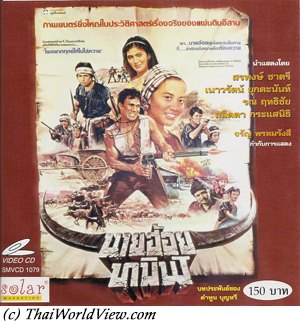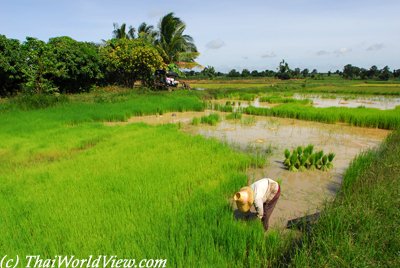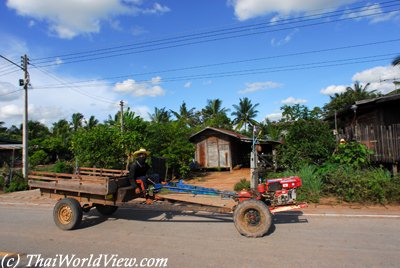HISTORY OF ISAN
Increase or decrease font size for easier reading : A+ A-
In the 15th century Laotian kingdom was used by Khmer kings as a buffer state between Khmer kingdom and Thai kingdom. At that time "ISAN" area was divided between Laotian kingdom and Khmer kingdom. Actual Laos and "ISAN" area were under the rule of the Siamese King since 1828. At the end of the last century French colonialist army occupied Laos and forced the Siam to withdraw from the right shore of the Mekong. At that time "ISAN" was included in Thai kingdom.
Isan people, living in 19 provinces, are mostly of Lao ethnic. In 1937, forests covered 60% of the northeast. This forest meant communication between villages was difficult and done usually by cart.
|
In the past, the Isan area was very remote and unsafe.
Thai cowboys were sending cattle through Isan area to Nakhorn Ratchasima.
Outlaws were waiting to steal the buffaloes.
Isan caravans were travelling to place with rivers, ponds where people
could fish and then bring back food to the village to sell it or keep it.
|

|
| Thai cowboys |
|---|
Most rebels in Isan history were ex-monks ("PHU MI BUN" - ผู้มีบุญ), probably due to the fact that their education mean that they could acquire knowledge and attract followers who respected them.
During Vietnam war, "ISAN" area received money thanks to the deployment of US military bases (Udon Thani, Ubon Ratchathani, Nakorn Phanom, Nakorn Ratchasima) in order to send bombs on Laos, Cambodia and Vietnam. In 1975 after Vietnamese, Laotian and Kampuchean governments became oriented by communism-socialism, Thailand worried that external powers might want it to become communist also. If Thailand might fall, "ISAN" area will be the entry point because it was the poorest area of Thailand. So central government feeling the danger did quite a lot for "ISAN" area development.

|
At the beginning of the 1980's there was a communist resistance (most of
them were students) in "ISAN".
Big parts of forests were destroyed in
order to discover the resistance shelters. Thanks to a specific law, all
were amnestied. Isan area has always had a reputation of
insurrectionary area.
|
| Thai farmer |
|---|
B the mid-1990s, Thailand has become an industrial capitalist economy. Thailand was a rural society but industrialization brought many big changes. Agricultural employment decreased as people sought employment in other sectors of the economy. In urban areas, young women flowed inside factories. They were called factory angels or เทพธิดาโรงงาน. A wealthy middle class appeared in cities and especially in Bangkok. Modernity brought new technology and consumption. Rural areas were also affected. Modernity brought new needs to rural areas so farmers needed more money. Farmers diversified their crops engaged in contract farming, borrowed more and turned to mechanisation. Inequality between rural and urban areas increased.
Opposition to some developments has been strong. In the 1980s and 1990s there was resistance to developments related to dams, forest clearance and eucalyptus plantations.
|
Some sources said that best development chances are
in the development of the Mekong trade. The Mekong River project might
be one of solution to develop economy in all area where the Mekong
river flows through.
|

|
| Thai farmer |
|---|

